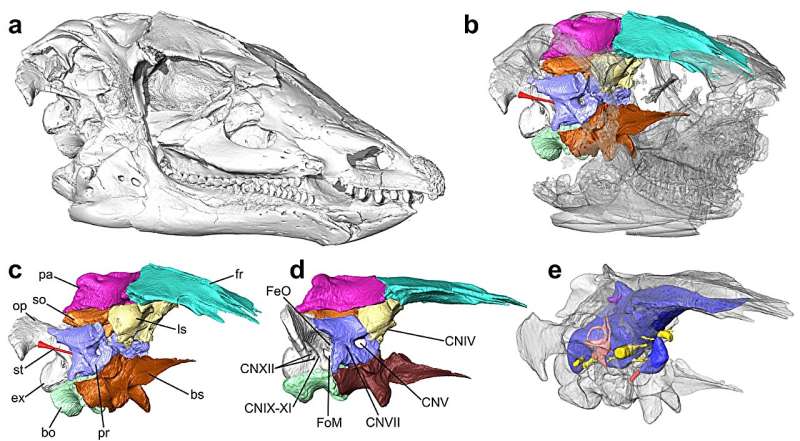This article has been reviewed according to Science X's editorial process and policies. Editors have highlighted the following attributes while ensuring the content's credibility:
fact-checked
peer-reviewed publication
trusted source
proofread
CT scan reveals 'neglected' dinosaur had super senses

A CT scan of an often-overlooked, plant-eating dinosaur's skull reveals that while it may not have been all that "brainy," it had a unique combination of traits associated with living animals that spend at least part of their time underground, including a super sense of smell and outstanding balance. The work is the first to link a specific sensory fingerprint with this behavior in extinct dinosaurs.
The dinosaur in question, Willo, is a specimen housed at the North Carolina Museum of Natural Sciences. Willo is a Thescelosaurus neglectus—a small (12 feet or 3.6 meters long) but heavy (750 pounds or 340 kilograms) herbivore that lived in what is now North America just before the end-Cretaceous mass extinction event, 66 million years ago.
Willo's scientific name roughly translates to "wonderful, overlooked lizard." But David Button, a former Brimley Postdoctoral Scholar at the North Carolina Museum of Natural Sciences and North Carolina State University, decided to look more closely at this "overlooked" dinosaur's skull. Button is currently a research associate at the University of Bristol in the U.K.
Button used a CT scanner to reconstruct soft tissues in Willo's skull—such as the brain and inner ear—that were lost to the fossilization process. Comparing these sensory structures to other dinosaurs and their living relatives allowed the researchers to determine the relative size of Willo's brain, as well as what her senses of smell, hearing, and balance were like. The research was published in Scientific Reports.
"The irony is that paleontologists generally think of these animals as pretty boring," says Lindsay Zanno, associate research professor at NC State, head of paleontology at the North Carolina Museum of Natural Sciences, and co-author of the work. "When we first looked at our results we thought, yeah, this animal is plain as toast. But then we took a big step back and realized there was something unique about the combination of Willo's sensory strengths and weaknesses."
Button and Zanno determined that T. neglectus' hearing range was limited. The dinosaur could only hear about 15% of the frequencies humans can detect, and between 4% to 7% of what dogs and cats can hear. In particular, T. neglectus was bad at hearing high-pitched sounds.
"We found that Thescelosaurus heard low frequency sounds best, and that the range of frequencies it could hear overlaps with T. rex," Zanno says. "This doesn't tell us they were adapted to hearing T. rex vocalize, but it certainly didn't hurt them to know when a major predator was tooling about in the area. More interesting to us was the fact that these particular deficiencies are often associated with animals that spend time underground."
Thescelosaurus balanced its poor hearing with an excellent sense of smell.
"We found that the olfactory bulbs—the regions of the brain that process smell—were very well developed in Thescelosaurus," Button says. "They were relatively larger than those of any other dinosaur we know of so far, and similar to those of living alligators, which can smell a drop of blood from miles away. Thescelosaurus may have used its similarly powerful sense of smell to instead find buried plant foods like roots and tubers. It also had an unusually well-developed sense of balance, helping it to pinpoint its body position in 3D space, another trait often found in burrowing animals."
T. neglectus' poor cognitive and hearing abilities, coupled with powerful arms and legs and overdeveloped senses of smell and balance, are all features characteristic of animals that spend time underground and/or engage in digging behaviors today.
"While we can't say definitively that these animals lived part of their lives underground, we know that their ancestors did," Button says. "This fact, together with their unique combination of sensory abilities, strongly suggests T. neglectus engaged in similar behaviors."
"We still don't know the sensory abilities of most dinosaurs," Zanno says. "That makes it difficult to link these traits to specific lifestyles with confidence, but it also means there are plenty of cool discoveries to come.
"The idea that there might have been dinosaurs living under the feet of T. rex and Triceratops is fascinating. No matter what, we now know for certain that T. neglectus isn't boring."
More information: David J. Button et al, Neuroanatomy of the late Cretaceous Thescelosaurus neglectus (Neornithischia: Thescelosauridae) reveals novel ecological specialisations within Dinosauria, Scientific Reports (2023). DOI: 10.1038/s41598-023-45658-3
Journal information: Scientific Reports
Provided by North Carolina State University





















